Fortum Bundle
Who are Fortum's Customers in Today's Energy Landscape?
In the dynamic world of energy, understanding the Fortum SWOT Analysis is vital for strategic success. With the global shift towards decarbonization and fluctuating energy prices, Fortum's ability to identify its customer base is more critical than ever. This exploration delves into the Fortum company's customer demographics and target market.
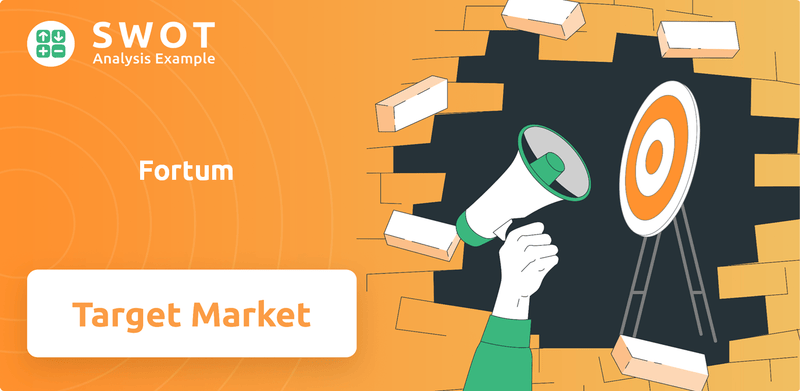
This market analysis provides a comprehensive overview of Fortum's customer demographics, examining its evolution from a Nordic energy provider to a diversified energy company. We'll explore customer segmentation, geographic targets, and the company's strategies for customer acquisition and retention, offering insights into who exactly makes up Fortum's target audience and how it adapts to meet their needs. This will include an in-depth look into Fortum customer profile analysis.
Who Are Fortum’s Main Customers?
Understanding the customer base of the Fortum company involves a deep dive into its diverse customer segments. This energy company operates primarily in the B2C and B2B sectors, with a strong presence in the Nordic and Baltic regions, as well as Poland. Analyzing the customer demographics and target market is crucial for understanding its strategic direction and market positioning.
Fortum's customer base is broad, encompassing both residential and business clients. Residential customers, who are part of the B2C segment, receive electricity, heating, and related energy services. Business customers, in the B2B segment, range from small to large corporations and municipalities. The company's focus on sustainable solutions and renewable energy reflects the evolving demands of its customer base.
The company's ability to adapt to changing market dynamics and customer preferences is essential for its continued success. A detailed market analysis of these segments reveals key insights into Fortum's strategic approach and future growth prospects. For further insights into the competitive landscape, consider exploring the Competitors Landscape of Fortum.
The B2C segment includes residential customers who receive electricity, heating, and energy services. A significant portion of this segment consists of environmentally conscious individuals seeking renewable energy options and digital energy management solutions. In 2024, Fortum had approximately 2.4 million electricity retail customers in the Nordics, demonstrating a substantial consumer base.
The B2B segment includes a wide array of businesses, from SMEs to large industrial corporations, municipalities, and energy companies. These customers require stable energy supply, energy efficiency solutions, and sustainability reporting. Fortum provides power generation, district heating and cooling, waste-to-energy solutions, and energy services to these clients.
The trends indicate a growing emphasis on customers who value sustainability, reliability, and innovative energy solutions. The increasing adoption of renewable energy and smart energy solutions is a prominent trend. Fortum is adapting to market changes by focusing on decentralized energy solutions, electric vehicle charging infrastructure, and digital customer interfaces.
- Growing demand for renewable energy.
- Increased interest in smart energy solutions.
- Focus on sustainable and reliable energy sources.
- Expansion of digital customer interfaces and services.
Fortum SWOT Analysis
- Complete SWOT Breakdown
- Fully Customizable
- Editable in Excel & Word
- Professional Formatting
- Investor-Ready Format
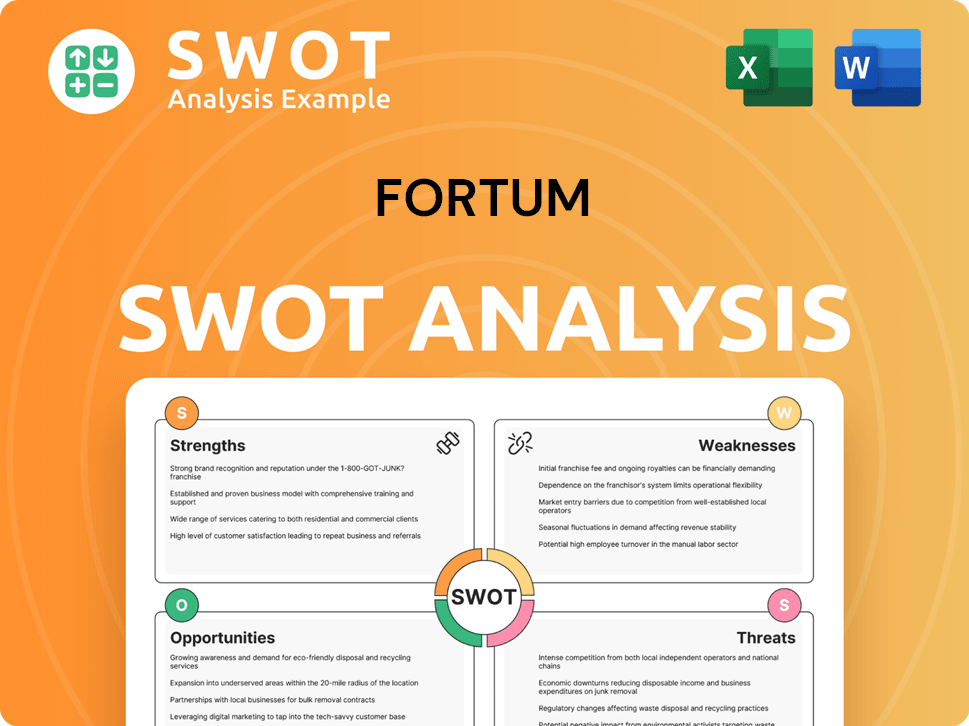
What Do Fortum’s Customers Want?
Understanding the customer needs and preferences is crucial for any business, and the Growth Strategy of Fortum hinges on this. This involves a deep dive into the motivations, behaviors, and expectations of its diverse customer base. The company tailors its offerings to meet the specific needs of both residential and business clients, ensuring customer satisfaction and loyalty.
For residential customers, the focus is on reliability, competitive pricing, and sustainability. Business clients, on the other hand, prioritize secure energy supply, cost predictability, and solutions that align with their sustainability goals. By addressing these varied needs, the company aims to strengthen its market position and foster long-term relationships with its customers.
The company's approach to customer satisfaction involves providing services that address common pain points, such as the complexity of energy markets and the desire for greater control over energy consumption. Through continuous innovation and a customer-centric strategy, the company aims to meet the evolving demands of its target market.
Residential customers of the company prioritize reliability, competitive pricing, and sustainability. They are increasingly seeking green energy options and transparent billing. The company offers 100% CO2-free electricity products to meet these needs.
Business customers, especially industrial and municipal clients, prioritize a secure and stable energy supply, energy efficiency, and cost predictability. They often require long-term contracts and tailored energy solutions. The company provides comprehensive energy solutions, including district heating and cooling.
The psychological drivers for residential customers often include a desire for environmental responsibility and a sense of contributing to a sustainable future. Practical drivers involve stable energy supply and cost efficiency. The company's offerings align with these motivations.
The company provides digital tools for energy consumption monitoring, such as the SmartLiving app. This reflects a preference for convenient digital solutions among residential customers. These tools help customers manage their energy use effectively.
The company's collaboration with SSAB to supply fossil-free electricity for steel production demonstrates its alignment with the industrial sector's need for decarbonization. This partnership highlights its commitment to providing sustainable energy solutions. This is an example of how the company addresses the needs of business customers.
The company addresses common customer pain points such as the complexity of energy markets and the need for reliable supply during peak demand. It also focuses on providing greater control over energy consumption and costs. Customer feedback influences product development.
The company's market analysis and customer segmentation strategy are crucial for understanding its target market. The company's customer acquisition strategy involves tailoring its marketing efforts to different segments. The company uses customer satisfaction metrics to measure its success.
- Customer Demographics: The company's customer base includes residential and business clients with varying needs and preferences.
- Target Market: The company targets both residential consumers seeking green energy and businesses prioritizing cost-effectiveness and sustainability.
- Customer Segmentation: The company segments its market based on needs, such as the desire for renewable energy or the need for cost-efficient solutions.
- Customer Acquisition Strategy: The company emphasizes the environmental benefits of its renewable energy offerings to eco-conscious consumers.
- Customer Retention Strategies: The company highlights cost savings and efficiency to business clients.
Fortum PESTLE Analysis
- Covers All 6 PESTLE Categories
- No Research Needed – Save Hours of Work
- Built by Experts, Trusted by Consultants
- Instant Download, Ready to Use
- 100% Editable, Fully Customizable
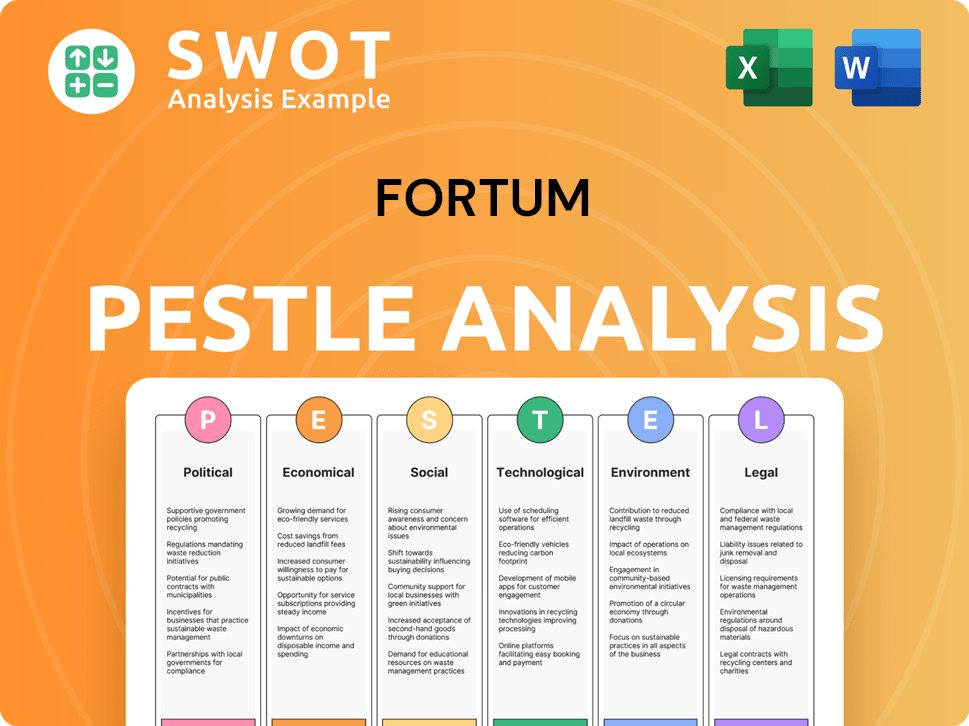
Where does Fortum operate?
The Fortum company has a significant geographical market presence, primarily focusing on the Nordic and Baltic countries, Poland, and previously Russia. This strategic focus allows the company to leverage its expertise in the energy sector within regions with strong growth potential and favorable regulatory environments. The company's operations are now concentrated in the EU and Norway following the strategic withdrawal from Russia, completed in May 2023.
The Nordic region, including Finland, Sweden, and Norway, serves as Fortum's core market. Here, the company holds a strong market share and brand recognition, particularly in electricity retail and district heating and cooling. This strong presence is supported by the region's high adoption rates of renewable energy solutions and digital services, aligning with the company's strategic goals. Fortum's market analysis shows a clear preference for sustainable energy solutions among Nordic customers.
Differences in customer demographics and preferences are evident across these regions, influencing Fortum's approach to customer segmentation. For example, Nordic customers often prioritize renewable energy and digital services, while markets like Poland may focus more on energy security and cost-effectiveness. This necessitates a localized approach to offerings and marketing, adapting to local regulatory frameworks and cultural nuances.
The Nordic region is the core market for Fortum, with a strong presence in Finland, Sweden, and Norway. This area accounts for a significant portion of the company's revenue and customer base. Fortum's customer base demographics in this region are characterized by a high awareness of and preference for renewable energy and digital services.
Fortum maintains a presence in Poland and the Baltic states, adapting its offerings to local market conditions. These markets may have different priorities, such as energy security and cost-effectiveness, compared to the Nordic region. The company's customer acquisition strategy involves tailoring its services to meet the specific needs of these diverse markets.
Fortum completed its strategic withdrawal from Russia in May 2023, marking a significant shift in its geographical focus. This decision has allowed the company to concentrate on its core European markets. The move has led to a greater emphasis on strengthening its position in its core European markets and developing its renewable energy portfolio.
Fortum employs customer segmentation to tailor its services and marketing efforts to different customer groups. This involves understanding the specific needs, preferences, and buying power of customers in each region. The company's customer retention strategies include providing customized energy solutions and excellent customer service.
Fortum's geographical target markets are characterized by distinct customer demographics and preferences, influencing the company's market segmentation strategy. Understanding these differences is crucial for effective customer acquisition and retention.
- Nordic Region: High preference for renewable energy, strong digital adoption.
- Poland: Emphasis on energy security and cost-effectiveness.
- Strategic Focus: Concentration on EU and Norway after the Russia exit.
- Customer Demographics: Varied across regions, requiring localized approaches.
Fortum Business Model Canvas
- Complete 9-Block Business Model Canvas
- Effortlessly Communicate Your Business Strategy
- Investor-Ready BMC Format
- 100% Editable and Customizable
- Clear and Structured Layout
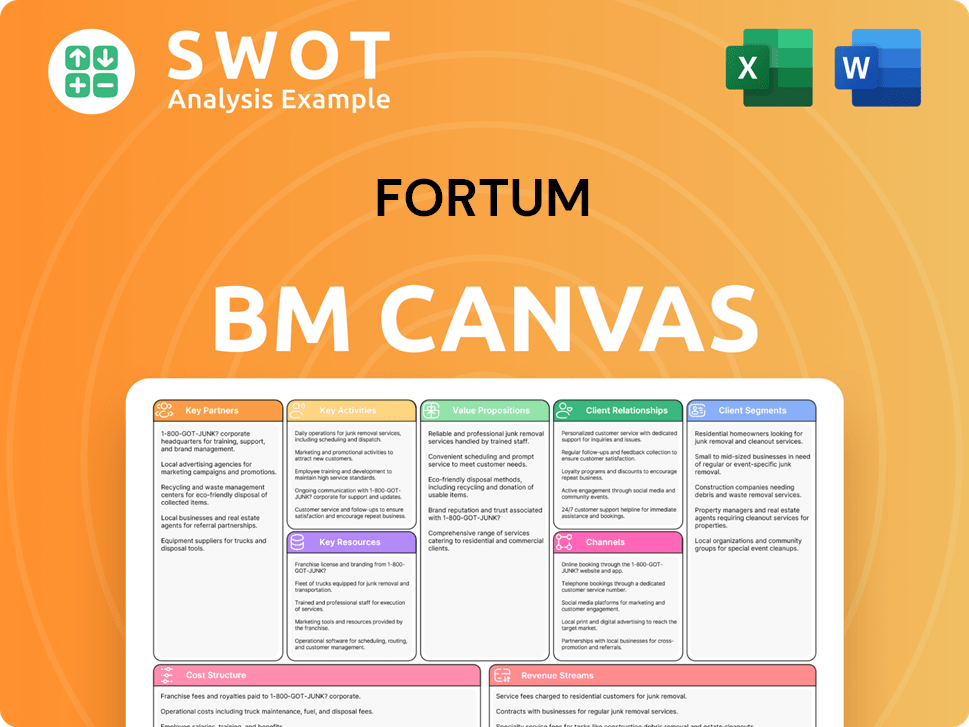
How Does Fortum Win & Keep Customers?
To attract and keep customers, the Fortum company uses a mix of methods. They use digital marketing, like online ads and social media, to reach both individual customers (B2C) and businesses (B2B). They also use traditional methods like print ads for local campaigns. Digital services and apps are key for customer engagement and self-service, emphasizing digital channels for getting and keeping customers.
For individual customers, they offer competitive prices, package deals (like electricity and heating), and promotions for renewable energy. For businesses, they offer expert advice to create custom energy solutions, including energy efficiency checks and long-term supply contracts. This approach helps them understand and meet the needs of different segments within their target market.
Loyalty programs and personalized experiences are becoming more important for keeping customers. They aim to build loyalty through reliable service, clear communication, and extra services. Customer data and CRM systems are essential for targeted campaigns and personalized offers, which increases customer lifetime value. By analyzing customer behavior, they can segment their customer base and offer relevant products and recommendations. This is a core part of their customer segmentation strategy.
Fortum's digital marketing includes online campaigns, social media, and search engine optimization to reach both B2C and B2B segments. They use digital services and apps for customer engagement and self-service, which is crucial for acquisition and retention. This strategy allows for targeted advertising and personalized customer experiences, improving customer lifetime value.
For B2C customers, Fortum uses competitive pricing, bundled services, and promotions for renewable energy. For B2B clients, they adopt a consultative sales approach, offering tailored energy solutions, energy efficiency audits, and long-term supply contracts. These strategies are designed to meet the specific needs of different customer demographics.
Fortum focuses on fostering customer loyalty through reliable service, transparent communication, and value-added services. They use customer data and CRM systems to enable targeted campaigns and personalized offers. Analyzing customer behavior allows for better segmentation and more relevant product recommendations, boosting customer lifetime value.
Acquisition campaigns highlight Fortum's commitment to sustainability and clean energy solutions, appealing to environmentally conscious customers. Retention initiatives include digital self-service platforms and educational content on energy saving. This focus on sustainability is a key element in attracting and retaining customers interested in renewable energy options, which is a key aspect of their market analysis.
Fortum's customer acquisition and retention strategies are centered around digital transformation and enhancing customer experience. They are integrating renewable energy solutions into their core offerings to meet evolving customer expectations.
- Digital transformation and customer experience enhancement are key.
- Integration of renewable energy solutions into core offerings.
- Focus on meeting evolving customer expectations.
- Improve customer loyalty and reduce churn rates.
Fortum Porter's Five Forces Analysis
- Covers All 5 Competitive Forces in Detail
- Structured for Consultants, Students, and Founders
- 100% Editable in Microsoft Word & Excel
- Instant Digital Download – Use Immediately
- Compatible with Mac & PC – Fully Unlocked
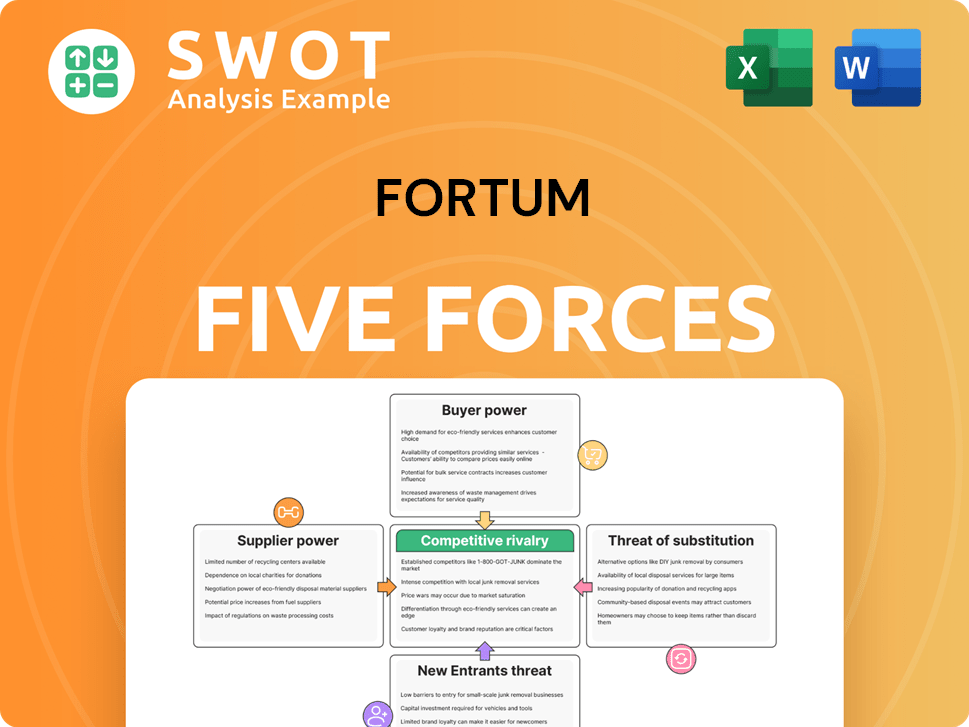
Related Blogs
- What are Mission Vision & Core Values of Fortum Company?
- What is Competitive Landscape of Fortum Company?
- What is Growth Strategy and Future Prospects of Fortum Company?
- How Does Fortum Company Work?
- What is Sales and Marketing Strategy of Fortum Company?
- What is Brief History of Fortum Company?
- Who Owns Fortum Company?
Disclaimer
All information, articles, and product details provided on this website are for general informational and educational purposes only. We do not claim any ownership over, nor do we intend to infringe upon, any trademarks, copyrights, logos, brand names, or other intellectual property mentioned or depicted on this site. Such intellectual property remains the property of its respective owners, and any references here are made solely for identification or informational purposes, without implying any affiliation, endorsement, or partnership.
We make no representations or warranties, express or implied, regarding the accuracy, completeness, or suitability of any content or products presented. Nothing on this website should be construed as legal, tax, investment, financial, medical, or other professional advice. In addition, no part of this site—including articles or product references—constitutes a solicitation, recommendation, endorsement, advertisement, or offer to buy or sell any securities, franchises, or other financial instruments, particularly in jurisdictions where such activity would be unlawful.
All content is of a general nature and may not address the specific circumstances of any individual or entity. It is not a substitute for professional advice or services. Any actions you take based on the information provided here are strictly at your own risk. You accept full responsibility for any decisions or outcomes arising from your use of this website and agree to release us from any liability in connection with your use of, or reliance upon, the content or products found herein.